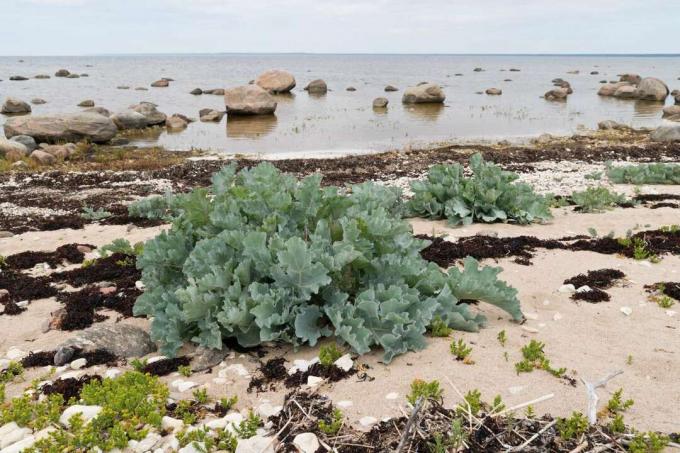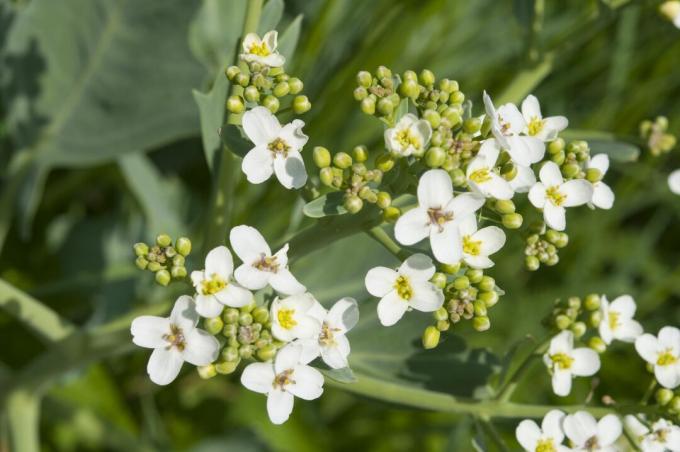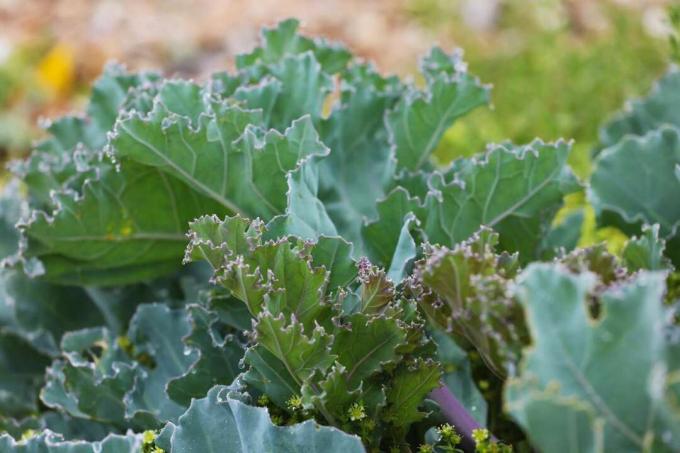Sea kale is an almost forgotten crop that has gained delicacy status in some countries. We present the unusual cabbage and give tips on growing it in your own garden.

The wild sea kale (Crambe maritima), also known as beach cabbage, also thrives on very salty soil right by the sea and used to be collected as animal feed. The fact that sea kale is undemanding and easy to care for and at the same time can be eaten as a vegetable early in the year has also made it a garden dweller over time. In this article you will learn everything about the origin, cultivation and care of sea kale.
contents
- Sea kale: origin and properties
- Types and varieties of sea kale
- plant sea kale
- Care of sea kale
- Harvest beach cabbage
- Eating and preparing sea kale
Sea kale: origin and properties
The sea kale comes wild along the East and North Sea coasts, on the Atlantic coast of Western Europe and on the Black Sea and used to be popular in Germany and all neighboring countries as food for people and cattle collected. Nowadays, the wild plants are strictly protected and may no longer be collected. Although sea kale is a cruciferous vegetable (Brassicaceae), it is only very distantly related to our well-known cabbage vegetables such as
broccoli (Brassica oleracea var. italiana) or palm cabbage(Brassica oleracea var. palmifolia) related.
Sea kale is a hardy and partly evergreen perennial with a deep taproot. The leaves and shoots usually die off in winter and sprout fresh again the following spring. Sea kale, also known as beach kale, has curled, turquoise to green-violet colored leaves that form a basal rosette. The heavily branched plant is about 20 to (rarely) 70 centimeters high. The flowering period lasts from May to July, during which sea kale forms thousands of white flowers on long inflorescences. After fertilization, roundish pods develop, inside each of which a single sea kale seed ripens. These seeds float on the surface of the water and are thus also spread by the tides and currents of the nearby sea. Sea kale is extremely tolerant of salinity and is therefore also referred to as a halophyte (salt plant). The sprout that sprout in the spring is considered a delicacy. It is bleached with the help of a clay pot and later prepared like asparagus.
Types and varieties of sea kale
The genus sea kale (crambe) consists of about 37 species, ten of which are native to Europe. In Europe, however, only sea kale is used for culinary purposes (Crambe maritima) and in Africa the Hispanic sea kale (Crambe hispanica). We owe the few varieties of real sea kale to the sporadic cultivation of the vegetable in France, Holland, North America and England. A distinction is made between the varieties 'Lily White', 'Ordinary Pink-Tipped' and 'Ivory White', which differ primarily in their foliage color and thus in their ornamental value.

plant sea kale
Sea kale can be seeded or planted. Propagation is also possible with the plant's own seeds or cuttings. The perennial perennials do not have to be sown or replanted every year.
The sea kale should be sown in March, either protected on a bright window sill or in a very warm, frost-protected location directly in the ground. If you let the seeds soak in water for a day and then plant them about 2 cm deep in the ground, the sea kale seeds will germinate much better and faster. Unfortunately, the seeds only have a very short shelf life, after a year the germination capacity is already noticeably reduced. Seeds you collect yourself should therefore be sown as quickly as possible. After a few weeks, the seedlings are planted out and separated at a distance of about 30 cm. Vegetative propagation via root or head cuttings of existing plants is easier. After only a few days, root growth of freshly cut cuttings begins in a nutrient-poor potting soil like ours Plantura herb and growing soil. When planting out, the sea kale should be placed in full sun on loamy-sandy, well-drained soil with sufficient nutrients. Young plants or seeds of sea kale are now offered by many rarity dealers, especially online. The collection of wild sea kale plants is prohibited under species protection law.
Care of sea kale
Immediately after planting, the sea kale should be watered a few times to promote root development. Although it never grows as luxuriantly in the garden as it does on its salty beaches, it can also reach decent sizes in our country. After the first year, the roots have grown well enough to provide the beach cabbage with water itself. Sea kale only needs additional irrigation during extremely long periods of drought. The nutrient requirement of beach cabbage is medium to high, especially if sprouts or leaves are harvested again and again. Regular fertilization with a predominantly organic long-term fertilizer like ours Plantura organic tomato fertilizer, replenishes the soil reserves of nutrients in the long term and evenly. Incidentally, it can already be applied when the sea kale is planted.
Harvest beach cabbage
The first shoots and leaves of the beach cabbage can be harvested as early as April - they are simply cut off with a sharp knife. In summer, the leaves already have a clear cabbage aroma and can then be used for hearty dishes.

Eating and preparing sea kale
Sea kale is usually bleached under an opaque clay pot and then cooked like asparagus. But unbleached, tender, young shoots also enrich the menu in April and May. With beach cabbage, however, you can also cook and use the leaves like ordinary cabbage leaves.
Another almost forgotten type of vegetable from earlier times is the chervil beet. You can find everything about the botany, cultivation and use of this root vegetable in our special article.



